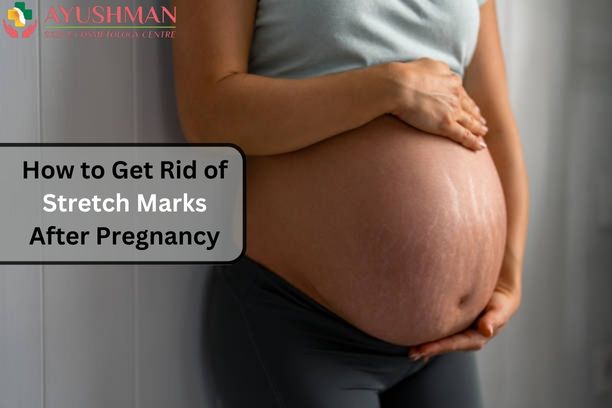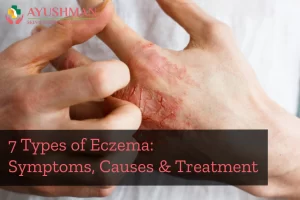When you’re pregnant, your body goes through many changes, and some of them might be unexpected. One common change is getting stretch marks on your belly as it grows during pregnancy. These marks usually take about a year to fade. While it might be a bit surprising or challenging to see these marks, it’s important to know they are a sign of the amazing thing your body just did – creating a new life. There’s no need to feel ashamed about them.
If you’re worried about how stretch marks look and want to know how to deal with stretch marks after pregnancy, keep reading. We’ve got advice from doctors to explain why stretch marks happen and how you can take care of them.
Don’t let stretch marks hold you back. Secure your spot for advanced stretch marks removal in Dwarka at Ayushman Skin & Cosmetology Centre. Click here to book and unveil smoother skin! Questions? Reach out to us at +91-9599816603/04.
Table of Contents
ToggleWhat Are Stretch Marks After Pregnancy?
Stretch marks after pregnancy are streaky lines or indents on the skin that can be pink, red, purple, or brown. In medical terms, they are called ‘striae gravidarum,’ which means pregnancy stripes in Latin. These marks are quite common and usually show up on the belly, breasts, thighs, buttocks, and sometimes on the upper arms.
Whether you get stretch marks after pregnancy and how noticeable they are can be influenced by genetics. If you have fair skin, they might be more visible. Factors like being a young mom, gaining a lot of weight rapidly during pregnancy, expecting twins or multiples, and losing weight post-pregnancy can make them more apparent. If you’ve had stretch marks before pregnancy or if others in your family have them, you may be more susceptible. Changes in hormone levels during pregnancy can also make the skin a bit thinner, increasing the likelihood of developing stretch marks.
Unleash your skin’s potential and erase those stretch marks! Book your appointment for stretch marks removal in Dwarka. Act now and experience the joy of rejuvenated, mark-free skin.
When Do Stretch Marks Show Up in Pregnancy?
You might be curious about when stretch marks show up during pregnancy, but the timing varies for each person. Stretch marks usually make their appearance later in pregnancy when the skin stretches due to weight gain and the growing baby and uterus. For some women, they may start to notice stretch marks in the second trimester, while others might not see them until the final weeks of the third trimester. Some lucky women don’t get any stretch marks at all.
Ready to say goodbye to stretch marks? Book your appointment now at Ayushman Skin & Cosmetology Centre in Dwarka for the best stretch marks removal in Dwarka. Don’t wait—schedule your appointment today and let us help you feel confident and beautiful in your skin again!
How to Reduce the Risk of Stretch Marks During Pregnancy
Unfortunately, there’s no surefire way to completely avoid stretch marks during pregnancy, and no magic cream can make them disappear. However, here are some tips to help minimize the risk of getting stretch marks and reduce their appearance:
Keep your weight gain moderate (around 25 to 30 pounds) and try to gain it gradually throughout the pregnancy. Following a healthy pregnancy diet can be beneficial.
Include skin-nourishing foods in your diet, such as antioxidant-rich vegetables like spinach, carrots, and sweet potatoes. Consume foods with vitamin E, such as nuts, avocados, broccoli, and seeds, along with an ample amount of protein from sources like yogurt and lentils if you’re a vegetarian.
- Stay well-hydrated by drinking plenty of water.
- Stick to your pregnancy exercise routine.
- Limit sun exposure to avoid skin damage.
- Wear a well-fitting, supportive bra to help prevent stretch marks on your breasts.
- While creams and oils may not completely prevent stretch marks, they can help keep your skin hydrated and alleviate itching, a common symptom as your skin stretches during pregnancy.
Treatments For Stretch Marks After Pregnancy
There are various treatments available for stretch mark removal, although complete elimination may not be guaranteed. The effectiveness of these treatments can vary among individuals, and it’s essential to consult with a healthcare professional or dermatologist to determine the most suitable approach. Here are some common treatments for stretch marks removal in Dwarka:
Topical Creams and Ointments:
- Retinoids: Derived from vitamin A, retinoids can help promote collagen production and improve the texture of the skin. However, they are not recommended during pregnancy or breastfeeding.
- Hydrating Creams and Lotions: Moisturizing the skin with products containing ingredients like hyaluronic acid, cocoa butter, shea butter, or vitamin E can improve skin elasticity and reduce the appearance of stretch marks.
Microdermabrasion: This procedure involves exfoliating the outer layer of the skin, which can improve the appearance of stretch marks. It is a non-invasive method that encourages the growth of new, healthier skin.
Chemical Peels: Chemical peels work by applying a solution to the skin, which helps remove the top layer. This process can boost collagen production and enhance skin texture. However, it’s essential to note that chemical peels may not be suitable for all skin types.
Microneedling: Microneedling uses tiny needles to create micro-injuries in the skin, promoting collagen production and skin renewal. Over time, this can aid in minimizing the visibility of stretch marks.
It’s crucial to note that individual responses to these treatments can vary, and some may be more effective for newer, red or purple stretch marks compared to older, white, or silver ones. Always consult with a healthcare professional or dermatologist before starting any treatment, especially during pregnancy or breastfeeding.
Is it Possible to Reduce Stretch Marks After Pregnancy?
While stretch marks may not completely disappear, they can gradually fade into a less noticeable silver color after pregnancy. While indulging in a massage can help you relax, be cautious of misleading claims regarding the effectiveness of creams, lotions, and oils in removing or preventing stretch marks. Some women may explore natural or Ayurveda treatments, but these don’t guarantee stretch mark removal. Laser treatment is an option some women consider after consulting with their doctors.
If you’re looking for the best stretch marks removal in Dwarka, Ayushman Skin & Cosmetology Centre is a reliable option.
It’s natural to feel concerned about the changes your body undergoes during pregnancy, but remember that your body is doing an incredible job protecting your little ones as they prepare to enter the world. These stripes are a testament to everything you’ve accomplished.
For more tips and guidance on maintaining a healthy pregnancy, visit our healthy pregnancy section. Whether you need week-by-week expert advice on a pregnancy calendar or tips on caring for a newborn, Pampers India is here to guide you through the amazing journey of early parenthood.
It’s time to reclaim your skin! Book your appointment for stretch marks removal in Dwarka at Ayushman Skin & Cosmetology Centre. Seize this opportunity to rediscover the beauty of your skin and bid farewell to stretch marks.
FAQs
Q: Can stretch marks go away after pregnancy?
A: Stretch marks may fade over time, but they typically do not completely disappear. While they may become less noticeable, complete removal is rare. Various treatments and remedies can help improve their appearance.
Q: How to remove stretch marks permanently naturally after pregnancy?
A: While there is no guaranteed natural method to permanently remove stretch marks, certain remedies may help minimize their appearance. These include moisturizing regularly with natural oils like coconut oil or shea butter, maintaining a healthy diet rich in vitamins and minerals, and staying hydrated. Time and consistency are key factors in seeing improvement.
Q: How do celebrities get rid of stretch marks after pregnancy?
A: Celebrities may use a combination of treatments to address stretch marks, including professional skincare treatments, laser therapy, and cosmetic procedures like microdermabrasion or chemical peels. It’s important to note that the effectiveness of these methods varies, and individual results may differ.
Q: What skin type is more prone to stretch marks?
A: People with skin that is less elastic or more prone to dryness are generally more susceptible to developing stretch marks. Additionally, individuals with a family history of stretch marks may be genetically predisposed to them. Pregnant women, adolescents undergoing growth spurts, and individuals who experience rapid weight changes are also more prone to developing stretch marks.
Q: Does drinking water help reduce stretch marks?
A: Staying hydrated is crucial for maintaining overall skin health, but there is limited evidence to suggest that drinking water alone can significantly reduce or prevent stretch marks. Hydration can, however, contribute to the overall health and elasticity of the skin.
Q: How can I stop stretch marks from looking worse?
A: To minimize the appearance of stretch marks, it’s essential to keep the skin well-hydrated by using moisturizers or oils. Regularly exfoliating the skin can also help promote cell turnover and improve the appearance of stretch marks. Maintaining a healthy weight and adopting a balanced diet rich in vitamins and minerals can contribute to skin elasticity, potentially preventing stretch marks from worsening. Using sunscreen can also protect the skin from damage that may exacerbate the appearance of stretch marks.







